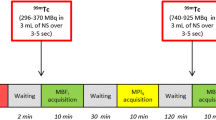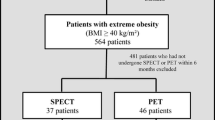Abstract
Background
The aim of this study was to compare the diagnostic performances for the detection of myocardial ischemia of 82-Rb-PET-MPS and 99m-Tc-SPECT-MPS in overweight individuals and women.
Methods and Results
Men with BMI ≥ 25 and women referred for MPS were considered for inclusion. All individuals underwent 99m-Tc-SPECT-MPS with CZT cameras and 82-Rb-PET-MPS in 3D-mode. Individuals with at least one positive MPS were referred for coronary angiography (CA) with FFR measurements. A criterion for positivity was a composite endpoint including significant stenosis on CA or, in the absence of CA, the occurrence of acute coronary event during the following year. 313 patients (46% women) with mean BMI of 31.8 ± 6.5 were included. Sensitivity for the detection of myocardial ischemia was higher with 82-Rb-PET-MPS compared with 99m-Tc-SPECT-MPS (85% vs. 57%, P < .05); specificity was equally high with both imaging techniques (93% vs. 94%, P > .05). 82-Rb-PET allowed for a more accurate detection of patients with a high-risk coronary artery disease (HR-CAD) than 99m-Tc-SPECT-MPS (AUC = 0.86 vs. 0.75, respectively; P = .04).
Conclusions
In women and overweight individuals, 82-Rb-PET-MPS provides higher sensitivity for the detection of myocardial ischemia than 99m-Tc-SPECT-MPS thanks to a better image quality and an improved detection of HR-CAD.





Similar content being viewed by others
Abbreviations
- CA:
-
Coronary angiography
- CAD:
-
Coronary artery disease
- CZT:
-
Cadmium-Zinc-Telluride
- FFR:
-
Fractional flow reserve
- MBq:
-
Mega-Becquerel
- MPS:
-
Myocardial perfusion scintigraphy
- SPECT:
-
Single Photon Emission Computed Tomography
- PET:
-
Positron Emission Tomography
- 82-Rubidium:
-
82-Rb
- 99m-Tc:
-
99m-Technetium
References
Nichols M, Townsend N, Scarborough P, Rayner M. Cardiovascular disease in Europe 2014: Epidemiological update. Eur Heart J 2014;35:2929.
Hachamovitch R, Hayes SW, Friedman JD, Cohen I, Berman DS. Comparison of the short-term survival benefit associated with revascularization compared with medical therapy in patients with no prior coronary artery disease undergoing stress myocardial perfusion single photon emission computed tomography. Circulation 2003;107:2900-7.
Task Force M, Montalescot G, Sechtem U, Achenbach S, Andreotti F, Arden C, et al. 2013 ESC guidelines on the management of stable coronary artery disease: the Task Force on the management of stable coronary artery disease of the European Society of Cardiology. Eur Heart J 2013;34:2949-3003.
Shaw LJ, Bairey Merz CN, Pepine CJ, Reis SE, Bittner V, Kelsey SF, et al. Insights from the NHLBI-Sponsored Women’s Ischemia Syndrome Evaluation (WISE) Study: Part I: Gender differences in traditional and novel risk factors, symptom evaluation, and gender-optimized diagnostic strategies. J Am Coll Cardiol 2006;47:S4-20.
Dunn JP, Huizinga MM, See R, Irani WN. Choice of imaging modality in the assessment of coronary artery disease risk in extreme obesity. Obesity 2010;18:1-6.
Sharir T, Ben-Haim S, Merzon K, Prochorov V, Dickman D, Ben-Haim S, et al. High-speed myocardial perfusion imaging initial clinical comparison with conventional dual detector anger camera imaging. JACC Cardiovasc Imaging 2008;1:156-63.
Imbert L, Poussier S, Franken PR, Songy B, Verger A, Morel O, et al. Compared performance of high-sensitivity cameras dedicated to myocardial perfusion SPECT: a comprehensive analysis of phantom and human images. J Nucl Med 2012;53:1897-903.
Agostini D, Marie PY, Ben-Haim S, Rouzet F, Songy B, Giordano A, et al. Performance of cardiac cadmium-zinc-telluride gamma camera imaging in coronary artery disease: a review from the cardiovascular committee of the European Association of Nuclear Medicine (EANM). Eur J Nucl Med Mol Imaging 2016;43:2423-32.
Verger A, Djaballah W, Fourquet N, Rouzet F, Koehl G, Imbert L, et al. Comparison between stress myocardial perfusion SPECT recorded with cadmium-zinc-telluride and Anger cameras in various study protocols. Eur J Nucl Med Mol Imaging 2013;40:331-40.
Schepis T, Gaemperli O, Treyer V, Valenta I, Burger C, Koepfli P, et al. Absolute quantification of myocardial blood flow with 13N-ammonia and 3-dimensional PET. J Nucl Med 2007;48:1783-9.
Knesaurek K, Machac J, Krynyckyi BR, Almeida OD. Comparison of 2-dimensional and 3-dimensional 82Rb myocardial perfusion PET imaging. J Nucl Med 2003;44:1350-6.
Le Guludec D, Lautamaki R, Knuuti J, Bax JJ, Bengel FM, Bax JJ. European Council of Nuclear C. Present and future of clinical cardiovascular PET imaging in Europe: A position statement by the European Council of Nuclear Cardiology (ECNC). Eur J Nucl Med Mol Imaging 2008;35:1709-24.
Sciagra R, Passeri A, Bucerius J, Verberne HJ, Slart RH, Lindner O, et al. Clinical use of quantitative cardiac perfusion PET: rationale, modalities and possible indications. Position paper of the Cardiovascular Committee of the European Association of Nuclear Medicine (EANM). Eur J Nucl Med Mol Imaging 2016;43:1530-45.
Diamond GA, Forrester JS. Analysis of probability as an aid in the clinical diagnosis of coronary-artery disease. N Engl J Med 1979;300:1350-8.
Dunet V, Klein R, Allenbach G, Renaud J, deKemp RA, Prior JO. Myocardial blood flow quantification by Rb-82 cardiac PET/CT: A detailed reproducibility study between two semi-automatic analysis programs. J Nucl Cardiol 2016;23:499-510.
Czernin J, Muller P, Chan S, Brunken RC, Porenta G, Krivokapich J, et al. Influence of age and hemodynamics on myocardial blood flow and flow reserve. Circulation 1993;88:62-9.
Dosimetry in diagnostic nuclear medicine. French Society of Medical Physics; 2001.
Senthamizhchelvan S, Bravo PE, Esaias C, Lodge MA, Merrill J, Hobbs RF, et al. Human biodistribution and radiation dosimetry of 82Rb. J Nucl Med 2010;51:1592-9.
The measurement, reporting, and management of radiation dose in CT. College Park: American Association of Physicists in Medicine; 2008.
De Bruyne B, Baudhuin T, Melin JA, Pijls NH, Sys SU, Bol A, et al. Coronary flow reserve calculated from pressure measurements in humans. Validation with positron emission tomography. Circulation 1994;89:1013-22.
Tonino PA, De Bruyne B, Pijls NH, van’ t Veer M, et al. Fractional flow reserve versus angiography for guiding percutaneous coronary interventio. N Engl J Med 2009;360:213-24.
Perrin M, Djaballah W, Moulin F, Claudin M, Veran N, Imbert L, et al. Stress-first protocol for myocardial perfusion SPECT imaging with semiconductor cameras: High diagnostic performances with significant reduction in patient radiation doses. Eur J Nucl Med Mol Imaging 2015;42:1004-11.
Danad I, Raijmakers PG, Driessen RS, Leipsic J, Raju R, Naoum C, et al. Comparison of coronary CT angiography, SPECT, PET, and hybrid imaging for diagnosis of ischemic heart disease determined by fractional flow reserve. JAMA Cardiol 2017;2:1100-7.
Hachamovitch R, Hayes S, Friedman JD, Cohen I, Shaw LJ, Germano G, et al. Determinants of risk and its temporal variation in patients with normal stress myocardial perfusion scans: What is the warranty period of a normal scan? J Am Coll Cardiol 2003;41:1329-40.
Yoshinaga K, Chow BJ, Williams K, Chen L, deKemp RA, Garrard L, et al. What is the prognostic value of myocardial perfusion imaging using rubidium-82 positron emission tomography? J Am Coll Cardiol 2006;48:1029-39.
Bateman TM, Heller GV, McGhie AI, Friedman JD, Case JA, Bryngelson JR, et al. Diagnostic accuracy of rest/stress ECG-gated Rb-82 myocardial perfusion PET: Comparison with ECG-gated Tc-99 m sestamibi SPECT. J Nucl Cardiol 2006;13:24-33.
Sampson UK, Dorbala S, Limaye A, Kwong R, Di Carli MF. Diagnostic accuracy of rubidium-82 myocardial perfusion imaging with hybrid positron emission tomography/computed tomography in the detection of coronary artery disease. J Am Coll Cardiol 2007;49:1052-8.
Agostini D, Roule V, Nganoa C, Roth N, Baavour R, Parienti JJ, et al. First validation of myocardial flow reserve assessed by dynamic (99 m)Tc-sestamibi CZT-SPECT camera: Head to head comparison with (15)O-water PET and fractional flow reserve in patients with suspected coronary artery disease. The WATERDAY study. Eur J Nucl Med Mol Imaging 2018;45:1079-90.
Acknowledgments
We wish to thank Souad Bani, Naima Beldjoudi, Lucile Collas, Audrey Pépin, and Sabrina Salhi who supported us in the setup and monitoring of the RUBIS study (from URC Paris Nord Val de Seine, Assistance Publique – Hôpitaux de Paris, DRCI, Paris, France), and patients who agreed to participate in this study.
Disclosures
Fabien Hyafil is consultant for Naogen and Curium, Dominique Le Guludec is consultant for Advanced Accelerator Applications. The authors Renata Chequer, Emmanuel Sorbets, Candice Estellat, Gregory Ducrocq, François Rouzet, Toni Alfaiate, Hamza Regaieg, Jérémie Abtan, Sébastien Leygnac, Milan Milliner, Laetitia Imbert, Samuel Burg, Rana Ben Azzouna, Louis Potier, Cédric Laouénan, Caroline Quintin, Ronan Roussel, Agnès Hartemann, Gilles Montalescot, Pierre-Yves Marie, Gabriel Steg have nothing to disclose in relation to this manuscript.
Author information
Authors and Affiliations
Corresponding author
Additional information
The authors of this article have provided a PowerPoint file, available for download at SpringerLink, which summarises the contents of the paper and is free for re-use at meetings and presentations. Search for the article DOI on SpringerLink.com.
Funding This study was fully supported by a grant from the French Ministry of Health (Programme Hospitalier de Recherche Clinique 2011 AOM11066).
Electronic supplementary material
Below is the link to the electronic supplementary material.
Rights and permissions
About this article
Cite this article
Hyafil, F., Chequer, R., Sorbets, E. et al. Head-to-head comparison of the diagnostic performances of Rubidium-PET and SPECT with CZT camera for the detection of myocardial ischemia in a population of women and overweight individuals. J. Nucl. Cardiol. 27, 755–768 (2020). https://doi.org/10.1007/s12350-018-01557-z
Received:
Accepted:
Published:
Issue Date:
DOI: https://doi.org/10.1007/s12350-018-01557-z




